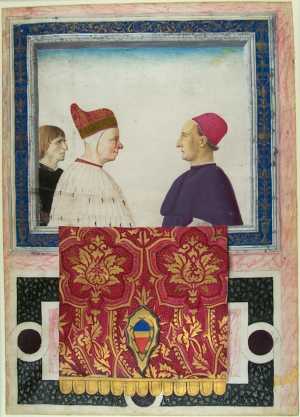Specifications
| Title | Portrait of Andrea Vendramin, Doge of Venice, with His Brother Luca and an Unidentified Papal Nuncio |
|---|---|
| Material and technique | Pen and brush and brown ink, bodycolour and gold, on parchment, pen and brush and brown ink, gouache and gold, on parchment |
| Object type |
Drawing
> Two-dimensional object
> Art object
|
| Location | This object is in storage |
| Dimensions |
Width 232 mm Height 325 mm |
|---|---|
| Artists |
Draughtsman:
Gentile Bellini
|
| Accession number | I 179 (PK) |
| Credits | Acquired with the collection of D.G. van Beuningen (former Koenigs collection), 1958 |
| Department | Drawings & Prints |
| Acquisition date | 1958 |
| Creation date | in circa 1477-1478 |
| Collector | Collector / Franz Koenigs |
| Mark | F.W. Koenigs (L.1023a deest), D.G. van Beuningen (L.758) |
| Provenance | Silvestro Bonfiglioli (1637-1696), Bologna; Bartolommeo Bonfiglioli, Bologna-Venice; sold by his heirs to Zaccaria Sagredo between 1728 and 1734; Zaccaria Sagredo (1653-1729, L.2103a, inv. deest), Venice (inserted in an album); Sagredo's albums sold by his heirs to Consul John Udny in 1763 and brought to England by him; Earls of Sunderland (in one of four Sagredo albums); by inheritance to George Charles Spencer Churchill, 8th Duke of Marlborough, Blenheim Palace, Woodstock; his sale, London (Christie) 15.06.1883, lot 15 (BP 44/18/0 to Mrs Noseda); - ; John Postle Heseltine (1843-1929, L.1507), London (cat. 1906, no. 1); possibly art dealers P. & D. Colnaghi & Obach, London (1912); Franz W. Koenigs (1881-1941, L.1023a), Haarlem, acquired in 1926; D.G. van Beuningen (1877-1955), Rotterdam, acquired with the Koenigs Collection in 1940; acquired with the Van Beuningen Collection in 1958 |
| Exhibitions | London 1912, no. 70; London 1930, no. 696; Amsterdam 1934, no. 432; Rotterdam 2009 (coll 2 kw 1); Rotterdam 2016 |
| Internal exhibitions |
Van Pisanello tot Cézanne (1992) De Collectie Twee - wissel I, Prenten & Tekeningen (2009) Rondom Fra Bartolommeo (2016) |
| Research |
Show research Italian Drawings 1400-1600 |
| Literature | Heseltine 1906, no. 1, ill. (Giovanni Bellini); Londen 1912, no. 70, pl. L; Venturi 1915, vol. 4, pp. 558-559, ill. 343 (Bellinesque); Haarlem 1926, no. 21, ill.; London 1930, no. 696 / London 1930a, no. 159, pl. 138 / London 1930b, no. 761 (Venetian 15th c.); Popham 1931, no. 159, pl. 138; Amsterdam 1934, nr. 432, ill. (Gentile attr.); Van Marle 1923-38, vol. 19 (1938), pp. 566, 568, fig. 309 (Jacometto?); Servolini 1944, pp. 30-31, pl. III (Jacometto?); Heinemann 1962, vol. 1, p. 240, no. V. 150, vol. 2, p. 619, fig. 713 (close to Gentile); Puppi 1969, p. 5 (Leonardo Bellini?); Collins 1970, p. 174 (School Gentile); Meyer zur Capellen 1985, pp. 181-182, App. VII,2, pl. 81, fig. 174 (Venetian); Heinemann 1991, p. 112 (Gentile) |
| Material | |
| Object | |
| Geographical origin | Italy > Southern Europe > Europe |
| Place of manufacture | Venice > Veneto region > Italy > Southern Europe > Europe |
Do you have corrections or additional information about this work? Please, send us a message
























